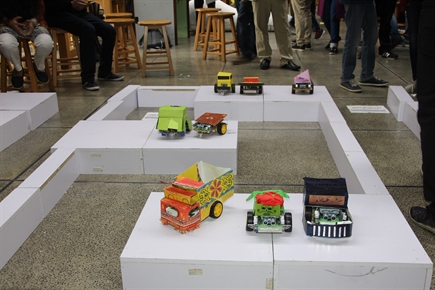Ahmad Kamal Nasir, PhD
Director engineering laboratory
Assistant professor of electrical engineering, school of science and engineering
lahore university of management sciences, pakistan
Course Description
This course is designed for freshmen engineering and science students to provide them a basic introduction of various stages involved in an engineering product design. It will help students to interpret and create computer aided mechanical parts and assembly drawings, interpret and create schematic and layout drawings for electronic circuits, Identify materials and select manufacturing processes for engineering products. Students will also be given an opportunity to get hands on experience on conventional and non-conventional machines such as CNC and 3D printers for rapid prototyping. The course is divided into four modules each of which contains lab tasks for practice and module project to test the concepts learned. The final module is a course project in which students shall use all the concepts learned in this course in order to consolidate their learning and to give them an opportunity to work with in larger team.

Course Learning Outcome
The students should be able to:
- Identify electrical/electronic devices and usage of electrical/mechanical measurement tools.
- Create and interpret electronic schematics and layout drawings.
- Create and interpret mechanical drawings.
- Use modern conventional workshop machines, CAD/CAM and other rapid prototyping tools for engineering product design.
Course Instructor
Dr. -Ing. Ahmad Kamal Nasir
Office Hours: Tuesday[1000-1100] Thursday[1000-1100]
Room: 9-345A, EE Department, 3rd Floor, Right Wing, School of Science and Engineering
Office Hours: Tuesday[1000-1100] Thursday[1000-1100]
Room: 9-345A, EE Department, 3rd Floor, Right Wing, School of Science and Engineering
Course Details
Core Course for Electrical Engineering
Catagory: Under-Graduate (1XXX level)
Semester: Fall 2016
Credits: 1
Pre-requisite (Topics/Skills): None
Grading Scheme: Course Project (30%), Final Examinations (36%), Lab Tasks (30%), Assignment (4%)
Course Delivery Method: Lecture (Monday: 1700 - 1850), Labs (Wednesday: 1700 - 1930)
Refrence Material: The course is taught from a combination of the following textbooks
A- Design and Technology, 2nd Edition, James Garratt, Cambridge University Press
B- Creo Parametric 2.0 Introduction, Christopher F. Sikora
C- Basic Engineering Drawing, R.S. Rhodes & L.B. Cook
Lectures and handouts will be provided where necessary
Catagory: Under-Graduate (1XXX level)
Semester: Fall 2016
Credits: 1
Pre-requisite (Topics/Skills): None
Grading Scheme: Course Project (30%), Final Examinations (36%), Lab Tasks (30%), Assignment (4%)
Course Delivery Method: Lecture (Monday: 1700 - 1850), Labs (Wednesday: 1700 - 1930)
Refrence Material: The course is taught from a combination of the following textbooks
A- Design and Technology, 2nd Edition, James Garratt, Cambridge University Press
B- Creo Parametric 2.0 Introduction, Christopher F. Sikora
C- Basic Engineering Drawing, R.S. Rhodes & L.B. Cook
Lectures and handouts will be provided where necessary
Course Contents
|
Week No. |
Module |
Topic |
Reference |
Additional Remarks |
| 1 |
PCB |
|
A-Ch6 |
CLO1, CLO2 Lab Task 1: 2% Lab Lecture 1 |
| 2 | PCB |
|
Lecture Notes |
Lab Task 2: 2% Lab Lecture 2 |
| 3 | PCB |
|
Lecture Notes |
Lab Task 3: 2% Lab Lecture 3 |
| 4 | PCB |
|
Lecture Notes |
Lab Task 4: 4% Lab Lecture 4 |
| 5 | CAD |
|
A- Ch2 C- Ch1,2 |
CLO3 Lab Task 5: 2% Lab Lecture 5 |
| 6 | CAD |
|
B |
Lab Task 6: 2% Lab Lecture 6 |
| 7 | CAD |
|
B |
Lab Task 7: 2% Lab Lecture 7 |
| 8 | CAD |
|
B |
Lab Task 8: 2% Lab Lecture 8 |
| 9 | CAD |
|
Lab Task 9: 4% Lab Lecture 9 |
|
| 10 |
Machining Processes |
|
Lecture Notes |
CLO1, CLO4 Lab Task 10: 2% Lab Lecture 10 |
| 11 |
Machining Processes |
|
Lecture Notes |
Lab Task 11: 2% Assignment: 4% Lab Lecture 11 |
| 12 |
Electrical & Panel Wiring |
|
Lecture Notes |
CLO1 Lab Task 12: 4% Lab Lecture 12 |
| 13 |
Course Project |
|
Lecture Notes |
CLO1, CLO2, CLO3 Course Project: Lecture 1 |
| 14 |
Course Project |
|
Lecture Notes |
CLO1, CLO2, CLO3 Course Project: Lectue 2 |
| 15 |
Course Project |
|



